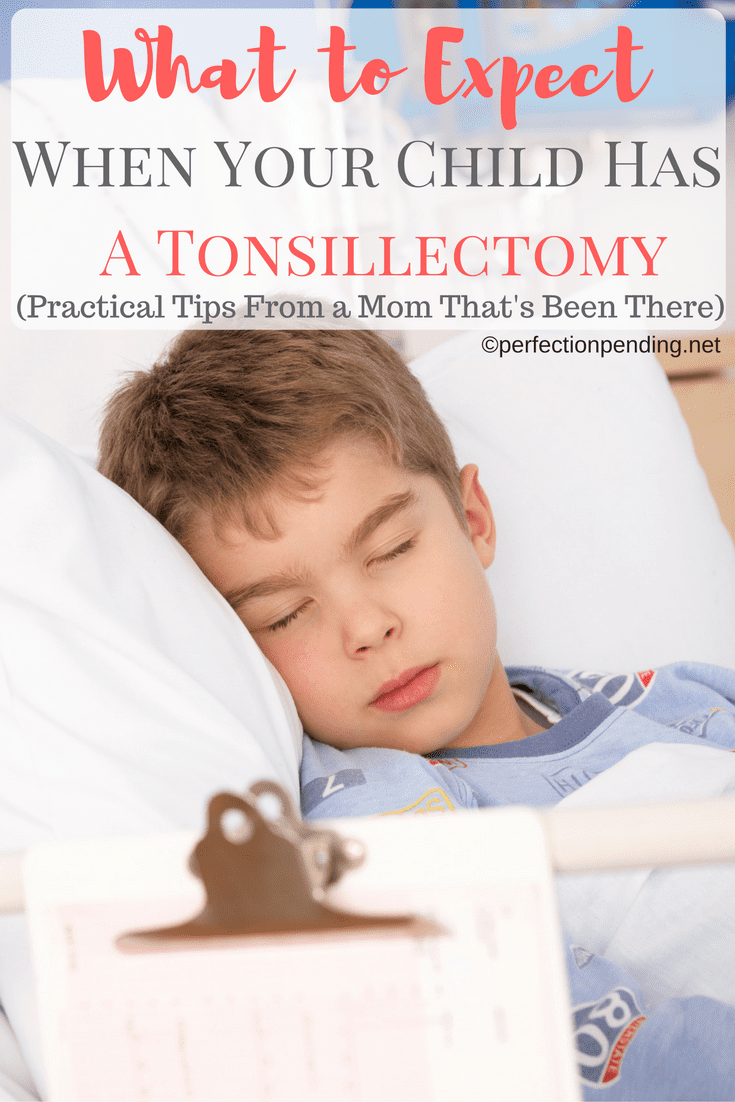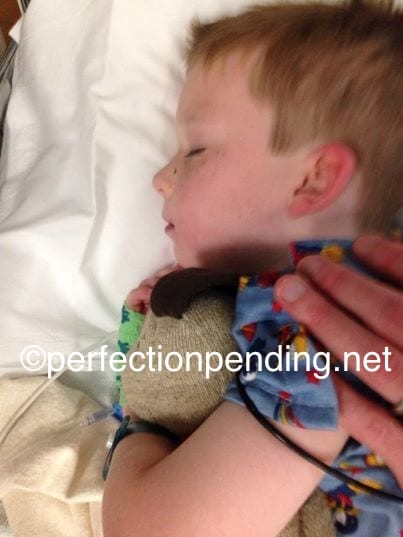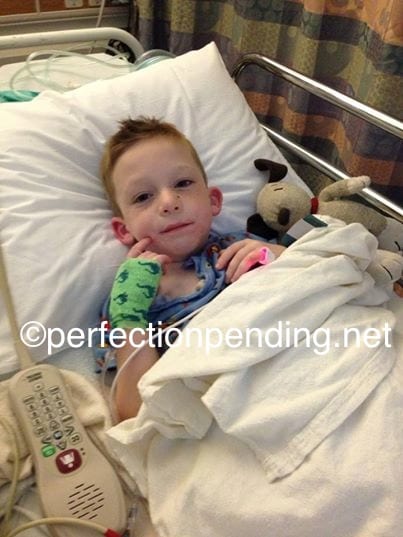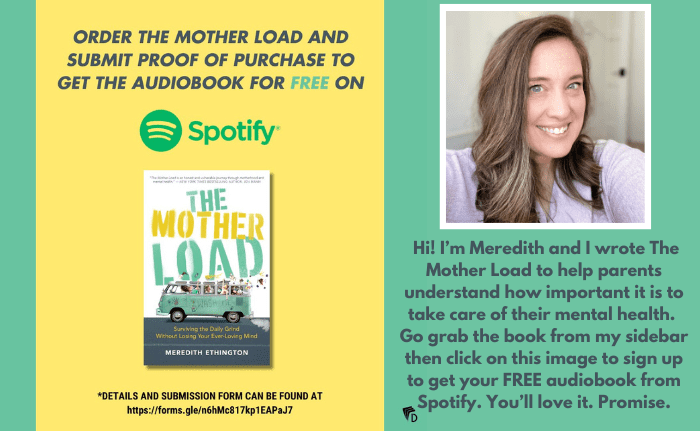My cousin teased me a bit when I went to FB asking my friends for tips on surviving my 5 year old’s upcoming tonsillectomy. I asked, “Any advice from anyone that’s gone through this?” She teased me because I was asking FB even though I’m married to a health professional. I told her that I wasn’t seeking medical advice on FB, I was seeking MOM advice.
Sometimes Mom advice is just as good, if not BETTER than what the doctor tells you, don’t you think? Which, incidentally had been not very helpful for practical use. Sure, he told me the recovery was 10 days (we were getting tonsils, adenoids, and tubes in the ears) and that pain medications were so good now that it was easily manageable through numbing lollipops, hydrocodone, and ibuprofen cocktails, but I wanted to know what it was REALLY going to be like.

Practical Mom Tips When Your Child Has a Tonsillectomy
Okay, so this surgery was years ago, but it still feels like it was yesterday. And while it has been a while, because I originally blogged about this on day 7 postop, it’s like a time warp. I’ve updated the post for clarity and ease, but I did leave as much of the original as possible because having another mom who’s been there to guide you through a scary experience is amazing and relieving.
Today, we are on day 7, and I have to say that we’re surviving, we might be going a little bit stir crazy, and I know it will all be over soon. But, when you’re anticipating your 5-year-old getting cut open (even if it IS a surgery they could do with their eyes closed) it is still scary. At least it was for this mama.
Here are 13 things I learned, and little tips that helped us.
This post contains Amazon affiliate links. If you click on a link, I may receive a commission. See my full disclosure policy here.
1. You will cry no matter how strong you are.
My youngest had surgery when he was 8 months old and I didn’t cry. But, this time around, there was something about seeing my big (yet tiny) 5 year old walk back through the surgery doors with an anesthesiologist, clutching his favorite stuffed animal, with his head down that almost ripped my heart in two. That image will be etched in my brain forever. I turned around to head to the waiting area and burst into tears. Some random guy in the hallway gave me sympathetic encouragement while my husband tried to console me.
2. Take their favorite toy to the hospital.
When my little guy was scared as we were preparing to have him go back, it gave him comfort to know that his favorite stuffed animal (Snoopy) would be right by his side. I told him I was jealous that Snoopy got to go into the surgery room with him. That made him smile. Here he is right after he got out clutching it. Breaks my heart.
3. Ask if they have a nurse or staff member to talk to them about the surgery beforehand.
We had my son’s surgery at a very reputable children’s hospital. We told the doctors that we were worried he might freak out once he was back there without us. They had a nurse come out with a book they had made of photos of the surgery room. It helped my son a lot to see pictures of the table he would lay on while he was in there, and they even brought a mask out beforehand to let him hold it and see. Doing this while he was with his parents was very comforting to him. You could also try a children’s book on getting your tonsils removed like this one.
4. You will buy popsicles, jello, pudding, ice cream, smoothie juices and plenty of yogurt and he might just want something random you didn’t think of.
My kid loves all of those things I listed that well-meaning people suggested I buy. But, the thing that sounded best to him? Sprite. Something I hadn’t bought, of course. But, it was easy enough to run to the store and get him some.
5. Your other kids will want to eat ice cream for dinner too.
Luckily, I bought plenty to share, because there was no telling the other two that the popsicles were just for Kyle and not for them. Make sure you factor that in when you are stocking up on soft, cold foods. And, it’s OK to let them all have 3 desserts after dinner.
6. Ramen Noodles are golden.
I also tried to stock up on soft foods he liked, but again, the only thing that sounded good was Ramen. Luckily, we stock up on that anyway. Ramen noodles are currently his main source of food. And, I’m OK with that. At least he’s eating.
7. Pain Meds might not go as planned.
I had the lollipops, hydrocodone and ibuprofen, and I was prepared to use them all. But, after the first day, we actually stopped the hydrocodone. It was upsetting his tummy and he was trying to throw up. After 24 hours, we tried again and did only half the recommended dosage and he did much better. In the meantime, Ibuprofen did the trick. I’ve been good at keeping the Ibuprofen in him at all times, but using the heavy duty stuff as needed. Which isn’t as often as you’d think.
8. Kids manifest pain differently.
I expected something totally different than what I got when it came to my son’s pain. He didn’t tell me he was in a lot of pain. But, I figured out that he was really quiet and mopey when he wasn’t feeling good. I was expecting tears or crying. Honestly, that didn’t really happen. Instead, he just moped, looked sad, and got really really quiet. Be in tune with what your kid might be telling you.
9. Get a Bell.
My husband had his tonsils out when he was a teenager. His Mom actually had a great idea since he didn’t want to talk. She got him a bell like this one. All these years later, and he still has that bell. So, guess who got to use it? My little man. We give it to him to keep by his bed at night so that he doesn’t have to yell for us from the other room. Use a baby monitor if you are worried about not hearing it. If your child is really struggling with speaking (mine did OK) you could let him carry it around all day if it isn’t going to drive you crazy.
10. Try not to freak out when your kid says something weird.
One night, our little man started saying that his tongue “felt weird” “felt shorter than normal” and “the purple medicine made his tongue hurt”. All of those things made me freak out and think he was having an allergic reaction. He wasn’t. That was a moment that I was glad my husband has a medical background. He checked him out and declared that we could go back to bed. But, not before I made our little guy sleep on the floor in our room for the night just in case. I have problems, I know. Be prepared to play musical beds. I slept in my 5 year old’s room that night.
11. Be OK with calling the doctor.
There was one night when my son’s fever got up to 101. I worried because our discharge instructions were scary, and they warned us that a 101 or higher fever could be a sign of infection. I wanted to call but my husband didn’t. Ultimately, I did. I felt so much better after. My doctor took it very seriously, and also made me feel better so that I wasn’t up all night worrying.
12. Stock up on different books and movies from the library.
Your child will get bored. Especially on the days when he is feeling good. Guess what? So will YOU! We were instructed to have no outdoor activities for 10 days! That’s a LONG time. There will be lots of downtime, snuggles, and taking it easy for everyone. Be prepared with something different to keep your child happy. Our Kindle was super inexpensive and perfect for those long days.
13. It’s an up and down roller coaster ride.
Every single day is unique. The first day, we breezed right through. He came home, felt happy, played video games, and ate solids within hours of surgery.
Day 2? Not so much. He was trying to throw up first thing in the morning, refusing meds, and super grouchy. Yesterday (day 6) was great. He got up and got dressed, wanted to run errands (I made him stay in the shopping cart) and ate a ton. Today he woke up miserable again. We’re on day 7. Don’t push your child to do more than they should because they have a good day. The next one could be a total wash. I’m hoping tomorrow will be easier.
I’m just glad we did it and we are doing much better than expected. My husband and I were super worried about how our son would react, but he’s really been doing awesome. Yes, there have been ups and downs, but for the most part, kids are resilient and will do great to a routine surgery like this one. And, I hope that the ear infections, ruptured ear drums and snoring will be behind us from now on.
Did you like this post? Make sure to pin it in case you or a friend ever needs some real life, mom advice!
This post is, of course, in no way real medical advice. This is Mom advice. Any questions or concerns need to be answered by a real doctor. I’m just a mom who’s been through it.
More on Tonsillectomies:
Want more doctor-based advice on tonsillectomies? Here you go:
- Tonsillectomy info by Mayo Clinic
- Tonsillectomy and adenotonsillectomy via Kids Health
- Tonsillectomy information by Health Line
My Must-Have Tonsillectomy Survival Resources:
- Our Kindle was super inexpensive and perfect for those long days.
- Get your little one a bell like this one.
- You could also try a children’s book on getting your tonsils removed like this one.
You’ll Also Love This Mom Advice:
- Mental Health Tips, Coping Skills, and Ideas to Manage Stress and Big Emotions
- Health Resources, Tips, and Pointers from an ER Nurse
- This Is By Far The Best Advice For New Moms
- Why Waiting Until You’re Ready to Have Kids is The Worst Advice Ever
- The Real Mom’s Guide To Getting Organized
If you liked this post, get my book, Mom Life: Perfection Pending. It’s a humorous look at parenting today and includes this kind of practical and practically awesome advice.







I have not had this surgery with either of mine yet, but I was still sucked into this post. Very interesting and good ideas that could be used for lots of different scenarios. I’m glad he is on the mend and hope he is back to 100% soon. My son had palate surgery at 16 months and I about lost it watching him wave to me as the surgeon carried him back through the doors. Of course he had no idea what he was in for and it was a very painful recovery. Ugh! Probably as bad for us as it is for them.
Sad! Anytime they have to have surgery it is so hard. My youngest had surgery in a very sensitive area (we’ll just leave it at that) and it was so sad to see him in pain!
Great tips Meredith, now I just have to store them in my brain in case I ever need them!
I have been there many times, my friend. It’s never easy to watch your child go through ANY surgery!! Bless his heart!! Such a cutie!
Great tips for sure. 🙂
Thanks so much!! My daughter is having her tonsils out on May 29th!! I’m going to need all the help I can get!!!
You are welcome! Good luck to you and your daughter. 🙂
My son is heading into surgery Wednesday. Your post was just what this mama was looking for. Thanks for the real perspective and tips. Btw, I’m married to a health professional as well, but hearing from another mama was just what the doctor ordered!
Oh good! I hope it helps. I looked for one too before my son had his surgery and couldn’t find one. I hope he recovers quickly and it’s not too difficult for any of you! Thanks for stopping by!
thanks for your post my daughter is going in next week and I’m pretty freaked out about it. Your advice has sort of prepared me lol. I hope.
Good luck! I was totally freaked out too, but it actually went so much smoother than I could have imagined! 🙂
Thank you so much for your details in dealing with a tonsillectomy! I am super nervous for my 3 year old to go in Monday although he’s been in for ear tubes as a baby. I’m definitely going to bookmark this page for solace when I feel like I’m at my wit’s end in the recovery period.
I will be taking my 5 year old son on Tuesday to get his tonsils and adenoids removed. Making my list so we can head to the store. Thanks for sharing.
Good luck Nicole! Hope it goes well.
My son is having the same three done next week. Thanks for the tips for this nervous mama!!
Ibuprofen? Sprite? We were told at the hospital that ibuprofen is a HUGE no and no carbonated drinks for 2 weeks. Did you really give him both?
I did! The ibuprofen was approved by my doctor too. It could be that with whatever pain meds your doc prescribed ibuprofen was off limits, but it was fine for us.
What a wonderful post to stumble upon! My little one is having her T&A this Friday and I’m nervous. I keep reassuring myself it’ll be fine and she’ll heal just fine and when I really doubt things I just take a peek at her GINORMOUS troublemakers and realize I’ve made the right decision. Thanks for the Mommy advice, you’ve helped to ease a nervous mom’s mind.
Good luck to your little one! My son’s surgery was life changing! He’s so much happier and hardly ever gets sick now!
You have helped to soothe this mommas soul! Thank you! So helpful being information from other moms! Thank you!
You’re welcome! That’s music to my ears!
100% spot on advice! My daughter had her tonsils and adenoids out in July and every one of your points applied to her as well. I wish I had read this BEFORE surgery! And she has done fantastic post op. Best decision we ever made for her
Thanks JoAnn! Same here. Best decision ever.
Thank you!
Our 5 year old boy is having his tonsils and adenoids out on Tuesday and I’m scared to death! I keep thinking he’s going to die, he won’t recover…
I’ve been told his voice will never be the same again and this makes me so sad but I just want him to make it through.
So thank you for this great article x
Ellen, I get it completely! I am worried sick about my girl. She has surgery scheduled for next month and I’m pretty nervous about it . I hope everything went well and that your little one has healed beautifully-and that the outcome was everything you had hoped.
I was told that ibuprofen is not supposed to be use! Only tylenol its on every paper that the doc gave me no ibuprofen
Well definitely go by what your doc advises because every doc prescribes different pain meds. With us it was ok to use with the meds we were prescribed.
It is deffinately a no before the surgery because it can cause heavy bleeding. We go Monday so I haven’t gotten my daughters post -op instructions ?
Thanks for the info! Great post! My son is 6 and is having his tonsils out next Friday. We had planned a family ski trip for three weeks later. I was just wondering if you think that he will be well enough to go. If not, I need to cancel our trip asap. Any advice would be appreciated! Thanks!
My son was totally back to normal by day 10. Good luck!!
I’m a nervous wreak about my 2 year olds surgery Monday. My main concern is her freaking out when they take her back and of course the recovery but I’m REALLY concerned she will throw a fit when she notices I’m not coming with her ??
I was worried about that too. Our children’s hospital had a book of pictures of the room to show him ahead of time, and then they let him choose a show on an iPad and carry that back with him to the room.
Thanks so much for this article. We just found out our grand baby, 4 years old, has to have her tonsils out March 2nd. Of course I’m worried. We’re going back to visit on an already planned trip on the 12 Th. It’s always scary when little ones have to have surgery. We can’t be there for the surgery or the first 10 days. But, I’m very thankful we’ll be able to be there shortly after and be able to give Mommy a break. And hold my little one. This is a great article. I wish things like this had been around when I was raising my son.
Aww. You sound like SUCH a good Grandma! Good luck to your little one! 🙂
It’s always hard to watch you child get surgery, no matter how common of a procedure it is. I don’t blame you at all for crying. I like your suggestion to ask a medical staff member to talk to your child about their surgery. Kids are often afraid of the unknown, so letting them know what will happen during the surgery should help calm them down a bit. Thanks for the tips.
Hi my 6 year old is having a tonsillectomy and grommitts inserted tomorrow and I just stumbled across your post thanks am very anxious
Thank you so much for your post … My 4 yr old son will have all 3 on Friday and we are super nervous… I know this is the best thing just worried
Good luck! It will all be OK. It was a life changer for my little guy!
Thanks for this post – especially your comments about kids manifesting pain differently! My daughter has become like an irrational two year old and I wish I’d been prepared for this! She’s usually a fairly articulate four year old, so I expected “my throat hurts” with tears, not kicking, biting, and stubborn refusal to take her codeine (argh…because that helps!). Days 6-7 have been our worst so far. Today will hopefully be better. I can hear her playing nicely with her brother, so hopefully this is the beginning of better!
Oh my god wish I’d found this 2 days ago I’ve just cancelled my sons opp as I went into meltdown after reading through all the risks 🙁
Oh shoot! Well, hopefully you got some reassurance now to move forward?
Thank you for your tips. My 4 year old is getting them out on Tuesday and Im nervous.
Good luck!!
My daughter is having this surgent in the am. Thanks for all the wonderful tips!!!
Good luck to you! I’m sure she’ll do great!
My son is having this done on Thursday and I have been trying to plan for the week or so ahead of us. As he has sensory issues and when he is in pain he doesn’t understand it. He also doesn’t react to pain like many people would, example he broke his colar bone and we didn’t know till the next day because he didn’t say it hurt at all till I got him dressed. So thankful I came across this post!!
I hope that all goes well! I believe my son has some sensory issues as well, and he did surprisingly well. Good luck!
My son will undergo to tonsillectomy & adenoids surgery. on this February. As a mother, it so painful to think he badly need. I feel so nervous… as of now my 5years old son had no idea. Hoping he will be ok.
I’m thankful I came across your article, prior to the tonsilectomy operation of my 8 year old daughter. It pains me thinking about the possibilities of the recovery process. She is scheduled tomorrow Feb 7, 2017 1pm. I have a lot of questions, that even withrawing is one of the possible options. Reading your articles with tips on smooth recovery still frightened me, but it helped me to understand to go the process. Thank you for the support.
Still I am asking your fervent prayer for safety and smooth, fast recovery.
Thank you.
Thank you for writing this post! My 3.5 year old son had a T & A and a 2nd set of ear tubes put in 10 days ago. Day of surgery and the first 3 afterwards were not too terrible. Days 6-9 were pretty horrendous. He was so irritable, so clingy yet I could tell he wanted so badly to feel ‘normal’. He was waking up sobbing, thrashing around and we would have to physically hold him down to give his medicine. Yesterday was definitely better, more energy, appetite starting to return. What has thrown me off is the insane lack of energy. He still has no interest in going outside to play, to the park, even for walks. Hoping for fresh air and some outdoor play today. Sleep at night has been non-existent. He will go to sleep at his normal bedtime and even if he makes it 3 or 4 hours, he is up crying. We are no longer managing his pain at night as it seems he’s moved past that but I really think the surgery does a number on these little ones and they essentially have to sleep train all over again. The doctors do NOT do a good enough job of preparing parents for this insanely difficult and trying couple of weeks. This is not, at least in our experience, a one week recovery. Looking more like a full 2+weeks before we can send him back to preschool. We are slowly starting to see glimpses of our happy and rambunctious 3 year old from before. Hoping for a brighter day today, filled with lots of smiles, play and a good night’s sleep. Please tell me the sleep returns.
We were told no outdoor activities for 10 full days. And, it seemed like clockwork that his energy returned and everything got back to normal around that time. Hope that it’s the same for your little guy!
Thank you for commenting because this is the exact experience we are currently have with our 4 year old. She is 8 days out from her T & A and days 6-8 have definitely been awful so far. It’s such a rollercoaster ride. One day she seems like she is doing better and the next is horrible again. It doesn’t seem like there is any end in sight. I am hoping she starts feeling better soon just like your kiddo!
Thank you so much for the good advice. Just found out today that my 6 year old son has to have tonsils and adenoids removed. They are so swollen you can’t see the back of his throat. Very nervous about this upcoming surgery but your post definitely helped with calming my nerves.
Good luck to your little one!
Thank you so much for this post! It was very helpful for me. My 7 year old daughter is have her Tonsils and adnoides removed on 3/23/17. I am a nervous wreck! So thanks for this helpful info.
Oh my gosh, I am so grateful to have found this post. You described the search perfectly– I have read through so many other sites on what to expect with my 8-year-old’s recovery from tonsillectomy next week, I just felt like I wasn’t getting the *mom* advice that I wanted. Then yours popped up, and what a godsend.
We already have a library trip for books&DVDs planned for 2 days before the surgery as well as a trip to build a bear planned for the day right before surgery ( which is an extra special treat as I have always thought of that place as a huge waste of money so she is very excited! ). The plan was to bring her “freshly built” buddy along with one of her favorite old ones, just in case 🙂
And I had what I thought was a thorough list of food and drinks but your list helped me add a couple things. Namely the sprite which is another huge treat for her and I think may brighten her mood at least a little bit once or twice. And for the record I really don’t get why commenters need to go on about the medical advice given to them that differs from that which was given to you– you couldn’t be more clear that you’re not giving medical. advice, just sharing your experience and what worked for you. Which I really couldn’t appreciate more right now!
I have gotten quite a few gifts from you in this post. First, I think it’s safe to say that I will indeed cry since I already had tears coming down, just reading your paragraph about that 😉
I really did though.
Also I immediately reserved the book you recommended from our library branch and am absolutely certain that will be a big help for us, as my daughter has always dealt much better with anxiety when given a decent and calm explanation of what she can expect. In fact we have had much great experience dealing with other anxieties through good books that explain well on their level. I’m actually really looking forward to the book.
ALSO I just hopped on Amazon and ordered a handbell like you’ve described– she’s going to love that. Especially when I drag myself to her over and over with an exaggeratedly strained look on my face! And the thought of her cherishing it later in life (which I can totally see happening) is almost making me cry again.
In fairness, it doesn’t take much for this soft mushy heart
THANK YOU
Good luck with the surgery! I hope your little one days great. Sounds like her mama is prepared, and loves her a lot. 🙂
My oldest daughter had her tonsils out April 4th 2017 and is not doing so good this help with the first few days and I love this website. Her younger brother just had brain surgery after suffering from brain cancer and he did not make it to this surgery or his 🙁
Thank you!! She did wonderfully, and I wanted to come here and add one more thing that might be helpful to others. After all our preparations, the only thing that still had her nervous the night before, was the iv. A google search for “kids iv ” delivered us a wonderful, CALM inducing but informative video that explained (and showed) the process. By the time she actually got the iv, the doctors were very impressed with her readiness. The book you recommended was also indeed a godsend, she loved it. Thank you again!
Three years later and your post is still helping nervous moms. ???? My 5 year old son will have the exact same procedures this Wednesday. You’ve added some things to my shopping and prep lists that I hadn’t thought of. Thanks!
You’re so welcome! Glad it helped!!
I’m so glad I found this! My daughter is going in for surgery for all 3 TOMORROW MORNING! I’m beyond terrified! I keep it together in front of her, but cry just thinking about any of it. She’s had 6 strep throats in 5 months and needs this so bad (kissing tonsils).
Your post made me feel a lot better (no lie, I will be a basket case as soon as she goes back without us)! I feel a lot better hearing it from a mom who’s been through it. Doctors can give you all the facts, but moms lay it out and know how other moms think and feel.
Thank you! And, I’m going to share this so others can feel reassured about their precious babies going in for this surgery ❤️
I’m so glad I found this, thank you! My 5 yo son is scheduled for May 19th and this post has calmed my nerves quite a bit 🙂
I have a 2 yr old will be getting this done pretty soon and I can’t help it, I’m scared and nervous. Reading this helped me a bit, wished my son was a bit older, but he suffers from sleep apnea and they suggested getting his tonsils and adenoids out.
how did your son do? my son is a little under two and I am freaking out… surgery is this coming week.
So glad I stumbled on this! I asked for advice on FB too and received texts from family that I am being a worry wart! This is my baby and I can’t help it! Thank you so much for the real mom advice! Surgery is tomorrow!
My 6 year old daughter is scheduled to go in for Tonsillectomy and Adenoid removal. I’m not as much worried about the surgery as much as I am about the recovery. I’ve read terrible things online regarding how much pain people are in around day 5-6.
Did your son experience a lot of pain at any point?
Well, I outline what he experienced each day. but, I remember day 7 was the hardest.
I took my son to the ENT yesterday and scheduled his T&A with turbinate reduction for 10/10, only for them to call this afternoon with a cancellation…we’re going in THIS Tuesday, 9/12! This blog post brought me to tears and I thank you, so much, for writing it. I’m a single mom of two boys so this “heads up” is priceless!
Thank you for posting this. My daughter is having this surgery on Monday and I have been crying and worrying all week. Reading this has helped me quite a bit. My husband and I both work in an ER so I immediately go to worst case scenario. I’m relieved to know that I’m not alone. Thank you again, I needed to read this tonight.
Thank you! My 8 year-old is having tonsils and adenoids removed Tuesday. This was very helpful.
Hey! I stumbled on this post and just wondering if anyone else’s kiddo had like what appears to be residual pain? Her ears never bothered her but after the t&a suregery (about a month out now) she complained of pain in her throats that shoots to her ear when she swallows. We have been to the dr and everything looks fine, negative for strep and everything. She’s five as well and just trying to see if you experienced this at all.
Thank you so much for this. I have now read it everyday for the past 4 days since my daughter has her tonsillectomy this Thursday. In addition she has to have two baby teeth pulled (unrelated but figured we would get it all done at the same time). My anxiety has been off the charts and I wish I could find a way to calm myself down. Work is a decent distraction (when I am busy) but truly trying not to cry at my desk from being frazzled. Just reading your blog and all of the mommy replies helps me to know that this will all be ok! Thanks again!
I loved reading your article, it was pretty much a image of my live. Seeing your baby (mine 7) walking into that room is heartbreaking and I cried reading your lines! His first day was awesome as well man he was going to eat a chicken if he could. Day two today and he isn’t doing great. I really have to push for his drinking and he isn’t eating very well! I hope he will get better as fast as your baby gotten! Ice Creme helps for sure. My son isn’t talking either he is writing on a white board :). I also sleep with him on the sofa ????. Hey it’s all about spoiling our children when they sick, that’s how they know they can count on mom when they need her! Hang in there moms. Nothing in my eyes is doing to much for them while they feel this way! Good luck
Hello, we just set a surgery date for my 7 yr old son who has obstructive sleep apnaea. June 26. (We are leaving/driving for vacation 8 days after that). He is having tonsils and adenoids removed and tubes put it. He does NOT handle pain well (like his mom) and dad does NOT handle crying grumpy children well. I’m worried that recovery is gonna be a hard road. Accidental pun now intended since we will actually be on the road.. I wanted to email this blog article to my husband but can’t seem to find a way to do that… Megbuchanan73@yahoo.com is my email if you could send me a copy… Please and thank you
your article moved me because iam a mother to 5 years old boy . you gave very useful tips to handle the situation.Thank you very much.
Thank you so much for this article. I’ve been trying to read up as much as I can. My two year old is scheduled for a adnoidectomy/tonsilectomy in just under two weeks and I’m currently 35 weeks pregnant. Needless to say, I’ve been a complete emotional mess since facing this decision. Since he has been experiencing sleep apnea the ENT was strongly against postponing it. I feel a bit more prepared for what’s to come. Thanks for sharing.
Thank you for posting this. My 2.5 year old son is on day 6. Day 5 was stinking awesome! He was eating regularly, and playing a whole lot. He has even been getting in the shower with me and playing for 30 mins very happily. Last night, everything went downhill. He seems like he is in so much pain. We had dropped the hydrocodone for plain Tylenol, but I have had to start it back up. Not really wanting to eat. The ONLY thing he wants is cartoons and my phone. I never let him play on my phone before this, so this is new. I even tried getting in the shower with him this morning, and he cried/screamed the whole time. I thought at first he was just wanting my phone, but I think that’s the only thing that is distracting him right now. I’m looking forward to maybe having an uphill climb here in the next couple of days. He’s my active, outdoors kid, and this has been awful for him.
My 4 year old had his Tonsils and Adenoids taken out as well on 7th of August. Its day 6 today and he is doing fairly well. He does not have much appetite as expected but is managing to eat if we feed him and we urge him to drink a lot of cold water and cold juice. He also does not want to talk much and saving up saliva in his mouth to avoid having to swallow. I was wondering if there is any remedy for the bad breath. Has anyone tried mints or perhaps listerine for kids?
My 3 year old will be having his adenoids and tonsils removed on Tuesday. Although, the hospital required us to come in tomorrow which is Monday to sleep over and have the procedure first thing on Tuesday.
My fear is he doesn’t like hospitals no matter how hard I try, so I know he might be uncomfortable sleeping overnight and also he hates staying with strangers without either of his parent so he’s most likely to cry when being wheeled into the theatre alone.
My other huge fear is my hubby also has an upcoming surgery (appendicitis) most likely by weekend and I will also need to be in the hospital with him 48 post op before he’s discharged.
May God help me through this. Amen
Just found your article. My 9-year-old is going in for a tonsillectomy, adenoidectomy and ear tubes next Thursday. I am so anxious I cry at night and during the day. I don’t let her see me getting upset! I am concerned with the anesthesia as she is overweight. Your post has helped but please ease my worry!